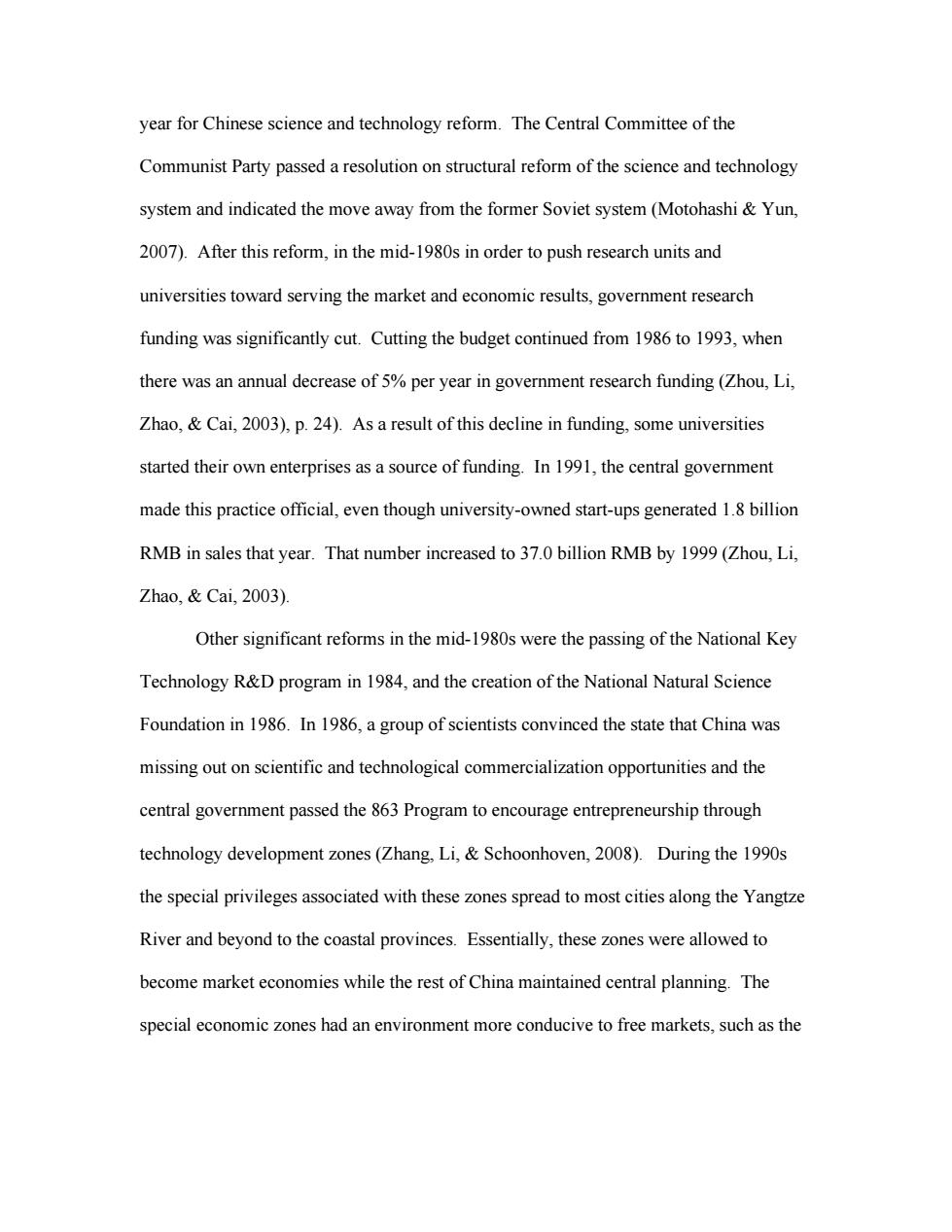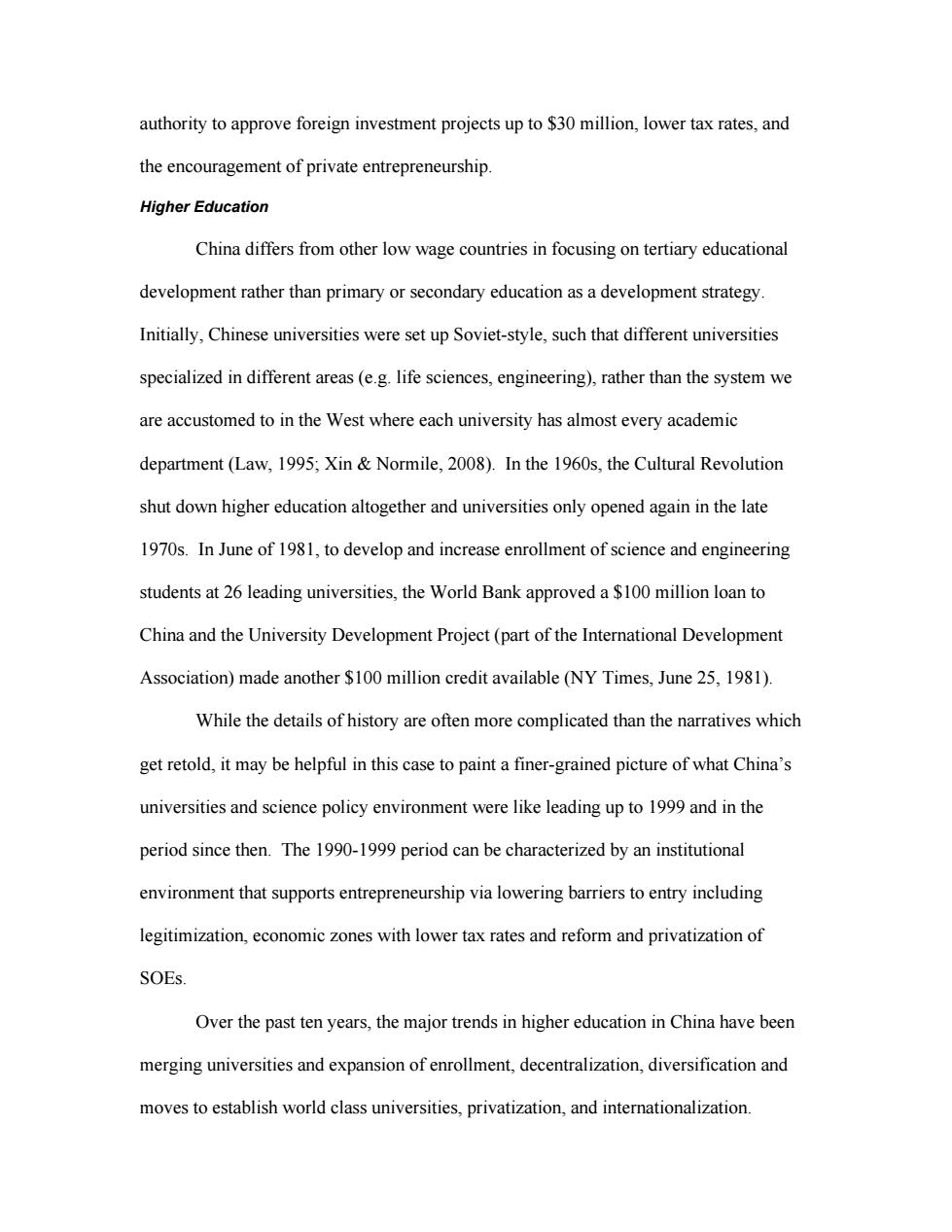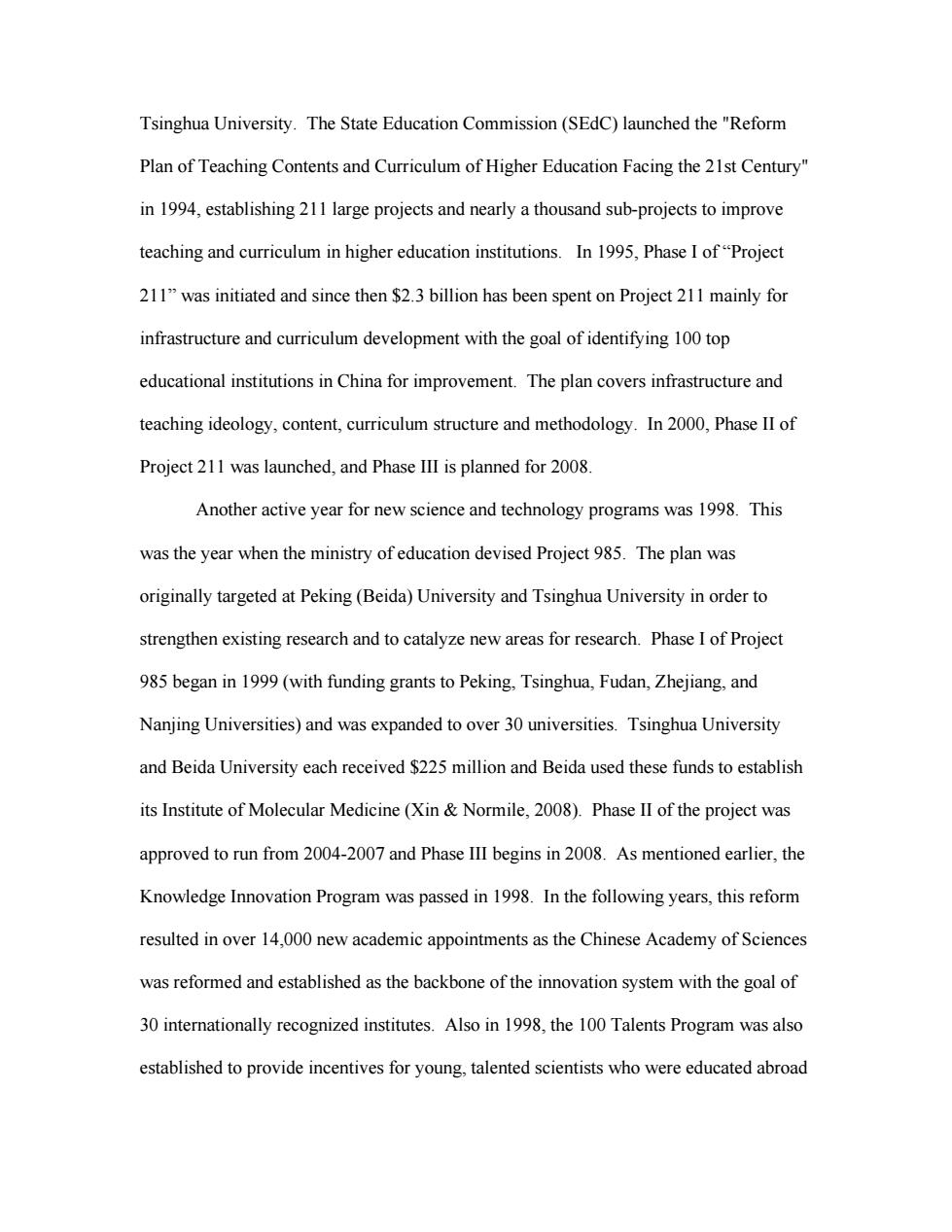
year for Chinese science and technology reform.The Central Committee of the Communist Party passed a resolution on structural reform of the science and technology system and indicated the move away from the former Soviet system(Motohashi&Yun, 2007).After this reform,in the mid-1980s in order to push research units and universities toward serving the market and economic results,government research funding was significantly cut.Cutting the budget continued from 1986 to 1993.when there was an annual decrease of 5%per year in government research funding(Zhou,Li. Zhao,&Cai,2003),p.24).As a result of this decline in funding,some universities started their own enterprises as a source of funding.In 1991,the central government made this practice official,even though university-owned start-ups generated 1.8 billion RMB in sales that year.That number increased to 37.0 billion RMB by 1999(Zhou,Li, Zhao,Cai,2003). Other significant reforms in the mid-1980s were the passing of the National Key Technology R&D program in 1984,and the creation of the National Natural Science Foundation in198.In 196.a group of scientists convinced the state that China was missing out on scientific and technological commercialization opportunities and the central government passed the 863 Program to encourage entrepreneurship through technology development zones(Zhang,Li,&Schoonhoven,2008).During the 1990s the special privileges associated with these zones spread to most cities along the Yangtze River and beyond to the coastal provinces.Essentially,these zones were allowed to become market economies while the rest of China maintained central planning.The special economic zones had an environment more conducive to free markets.such as the
year for Chinese science and technology reform. The Central Committee of the Communist Party passed a resolution on structural reform of the science and technology system and indicated the move away from the former Soviet system (Motohashi & Yun, 2007). After this reform, in the mid-1980s in order to push research units and universities toward serving the market and economic results, government research funding was significantly cut. Cutting the budget continued from 1986 to 1993, when there was an annual decrease of 5% per year in government research funding (Zhou, Li, Zhao, & Cai, 2003), p. 24). As a result of this decline in funding, some universities started their own enterprises as a source of funding. In 1991, the central government made this practice official, even though university-owned start-ups generated 1.8 billion RMB in sales that year. That number increased to 37.0 billion RMB by 1999 (Zhou, Li, Zhao, & Cai, 2003). Other significant reforms in the mid-1980s were the passing of the National Key Technology R&D program in 1984, and the creation of the National Natural Science Foundation in 1986. In 1986, a group of scientists convinced the state that China was missing out on scientific and technological commercialization opportunities and the central government passed the 863 Program to encourage entrepreneurship through technology development zones (Zhang, Li, & Schoonhoven, 2008). During the 1990s the special privileges associated with these zones spread to most cities along the Yangtze River and beyond to the coastal provinces. Essentially, these zones were allowed to become market economies while the rest of China maintained central planning. The special economic zones had an environment more conducive to free markets, such as the

authority to approve foreign investment projects up to $30 million,lower tax rates,and the encouragement of private entrepreneurship. Higher Education China differs from other low wage countries in focusing on tertiary educational development rather than primary or secondary education as a development strategy. Initially,Chinese universities were set up Soviet-style,such that different universities specialized in different areas(e.g.life sciences,engineering),rather than the system we are accustomed to in the West where each university has almost every academic department(Law,1995;Xin&Normile,2008).In the 1960s,the Cultural Revolution shut down higher education altogether and universities only opened again in the late 1970s.In June of 1981,to develop and increase enrollment of science and engineering students at 26 leading universities,the World Bank approved a$100 million loan to China and the University Development Project(part of the International Development Association)made another $100 million credit available(NY Times,June 25,1981) While the details of history are often more complicated than the narratives which get retold,it may be helpful in this case to paint a finer-grained picture of what China's universities and science policy environment were like leading up to 1999 and in the period since then.The 1990-1999 period can be characterized by an institutional environment that supports entrepreneurship via lowering barriers to entry including legitimization,economic zones with lower tax rates and reform and privatization of SOEs Over the past ten years,the major trends in higher education in China have been merging universities and expansion of enrollment,decentralization,diversification and moves to establish world class universities,privatization,and internationalization
authority to approve foreign investment projects up to $30 million, lower tax rates, and the encouragement of private entrepreneurship. Higher Education China differs from other low wage countries in focusing on tertiary educational development rather than primary or secondary education as a development strategy. Initially, Chinese universities were set up Soviet-style, such that different universities specialized in different areas (e.g. life sciences, engineering), rather than the system we are accustomed to in the West where each university has almost every academic department (Law, 1995; Xin & Normile, 2008). In the 1960s, the Cultural Revolution shut down higher education altogether and universities only opened again in the late 1970s. In June of 1981, to develop and increase enrollment of science and engineering students at 26 leading universities, the World Bank approved a $100 million loan to China and the University Development Project (part of the International Development Association) made another $100 million credit available (NY Times, June 25, 1981). While the details of history are often more complicated than the narratives which get retold, it may be helpful in this case to paint a finer-grained picture of what China’s universities and science policy environment were like leading up to 1999 and in the period since then. The 1990-1999 period can be characterized by an institutional environment that supports entrepreneurship via lowering barriers to entry including legitimization, economic zones with lower tax rates and reform and privatization of SOEs. Over the past ten years, the major trends in higher education in China have been merging universities and expansion of enrollment, decentralization, diversification and moves to establish world class universities, privatization, and internationalization

University enrollment(broadly defined by the Ministry of Education Statistics)has ballooned from under three million in 1995 to over 18 million students enrolled in 2007 (Figure 2).According to the National Bureau of Statistics of China,restricting the definition to four year colleges and universities,the total number of graduates has gone from 80,000 in 1998 to just over three million in 2005.Since 1999,the number of undergraduate and graduate students has grown at nearly 30%per year.However, evidence indicates that quantity has been expanded at the expense of the quality of the graduates(Gereffi,Wadhwa,Rissing.&Ong.2008). Insert Figure 2 here Ministry of Education ofChina:National Bureau of Statistics The Chinese government appears to be using education policies as a mechanism to maintain high economic growth via skill upgrading(Li,Whalley,Zhang,Zhao, March 2008).A national forum decision to encourage the consolidation of institutions and decentralization in December of 1994 caused another wave of change in the universities.The percentage of national universities went from 51%to9%between 1995 and 2002 as decentralization moved centrally controlled universities to the jurisdiction of local governments(Zhou,Li,Zhao,&Cai,2003).Consolidation was particularly rapid between 1999 and 2006 when 60%of the 431 consolidations between 1990 and May of 2006 occurred(Li,Whalley,Zhang,&Zhao,March 2008).For example,in major cities four or five smaller universities could move to improve their ranking by consolidating into a single university.Beijing Medical University was incorporated into Peking University in 2000 and the Central Arts and Design College was incorporated into
University enrollment (broadly defined by the Ministry of Education Statistics) has ballooned from under three million in 1995 to over 18 million students enrolled in 2007 (Figure 2). According to the National Bureau of Statistics of China, restricting the definition to four year colleges and universities, the total number of graduates has gone from 830,000 in 1998 to just over three million in 2005. Since 1999, the number of undergraduate and graduate students has grown at nearly 30% per year. However, evidence indicates that quantity has been expanded at the expense of the quality of the graduates (Gereffi, Wadhwa, Rissing, & Ong, 2008). ----------------------------- Insert Figure 2 here ------------------------------- Ministry of Education of China; National Bureau of Statistics The Chinese government appears to be using education policies as a mechanism to maintain high economic growth via skill upgrading (Li, Whalley, Zhang, & Zhao, March 2008). A national forum decision to encourage the consolidation of institutions and decentralization in December of 1994 caused another wave of change in the universities. The percentage of national universities went from 51% to 9% between 1995 and 2002 as decentralization moved centrally controlled universities to the jurisdiction of local governments (Zhou, Li, Zhao, & Cai, 2003). Consolidation was particularly rapid between 1999 and 2006 when 60% of the 431 consolidations between 1990 and May of 2006 occurred (Li, Whalley, Zhang, & Zhao, March 2008). For example, in major cities, four or five smaller universities could move to improve their ranking by consolidating into a single university. Beijing Medical University was incorporated into Peking University in 2000 and the Central Arts and Design College was incorporated into

Tsinghua University.The State Education Commission(SEdC)launched the"Reform Plan of Teaching Contents and Curriculum of Higher Education Facing the 21st Century" in 1994,establishing 211 large projects and nearly a thousand sub-projects to improve teaching and curriculum in higher education institutions.In 1995,Phase I of"Project 211"was initiated and since then $2.3 billion has been spent on Project 211 mainly for infrastructure and curriculum development with the goal of identifying 100 top educational institutions in China for improvement.The plan covers infrastructure and teaching ideology,content,curriculum structure and methodology.In 2000,Phase II of Project 211 was launched,and Phase III is planned for 2008 Another active year for new science and technology programs was 1998.This was the year when the ministry of education devised Project 985.The plan was originally targeted at Peking(Beida)University and Tsinghua University in order to strengthen existing research and to catalyze new areas for research.Phase I of Project 985 began in 1999(with funding grants to Peking,Tsinghua,Fudan,Zhejiang.and Nanjing Universities)and was expanded to over 30 universities.Tsinghua University and Beida University each received $225 million and Beida used these funds to establish its Institute of Molecular Medicine(Xin&Normile,2008).Phase II of the project was approved to run from 2004-2007 and Phase III begins in2008.As mentioned earlier,the Knowledge Innovation Program was passed in 1998.In the following years,this reform resulted in over 14,000 new academic appointments as the Chinese Academy of Sciences was reformed and established as the backbone of the innovation system with the goal of 30 internationally recognized institutes.Also in 1998.the 100 Talents Program was also established to provide incentives for young,talented scientists who were educated abroad
Tsinghua University. The State Education Commission (SEdC) launched the "Reform Plan of Teaching Contents and Curriculum of Higher Education Facing the 21st Century" in 1994, establishing 211 large projects and nearly a thousand sub-projects to improve teaching and curriculum in higher education institutions. In 1995, Phase I of “Project 211” was initiated and since then $2.3 billion has been spent on Project 211 mainly for infrastructure and curriculum development with the goal of identifying 100 top educational institutions in China for improvement. The plan covers infrastructure and teaching ideology, content, curriculum structure and methodology. In 2000, Phase II of Project 211 was launched, and Phase III is planned for 2008. Another active year for new science and technology programs was 1998. This was the year when the ministry of education devised Project 985. The plan was originally targeted at Peking (Beida) University and Tsinghua University in order to strengthen existing research and to catalyze new areas for research. Phase I of Project 985 began in 1999 (with funding grants to Peking, Tsinghua, Fudan, Zhejiang, and Nanjing Universities) and was expanded to over 30 universities. Tsinghua University and Beida University each received $225 million and Beida used these funds to establish its Institute of Molecular Medicine (Xin & Normile, 2008). Phase II of the project was approved to run from 2004-2007 and Phase III begins in 2008. As mentioned earlier, the Knowledge Innovation Program was passed in 1998. In the following years, this reform resulted in over 14,000 new academic appointments as the Chinese Academy of Sciences was reformed and established as the backbone of the innovation system with the goal of 30 internationally recognized institutes. Also in 1998, the 100 Talents Program was also established to provide incentives for young, talented scientists who were educated abroad